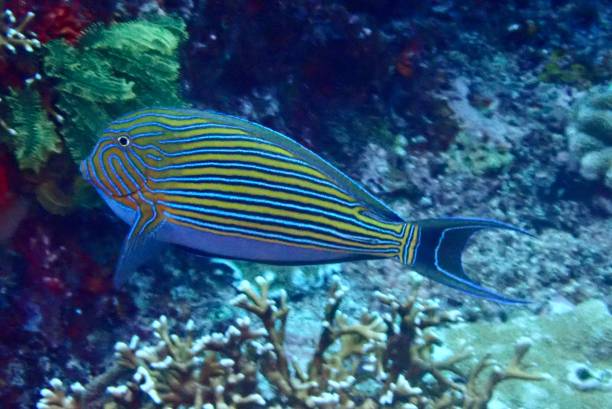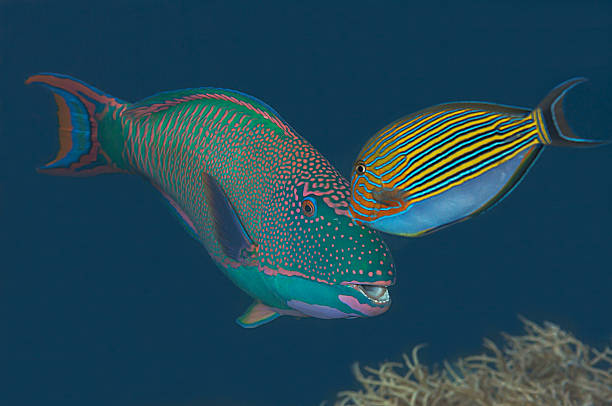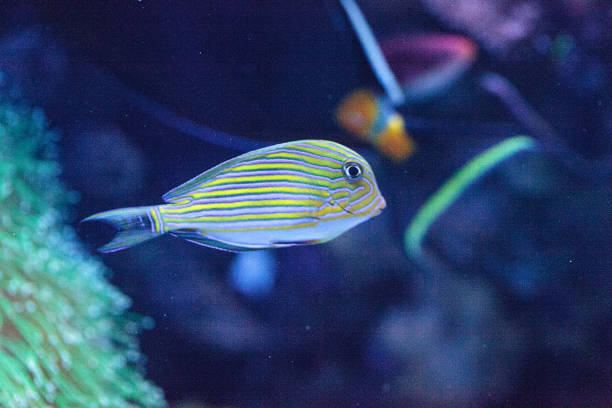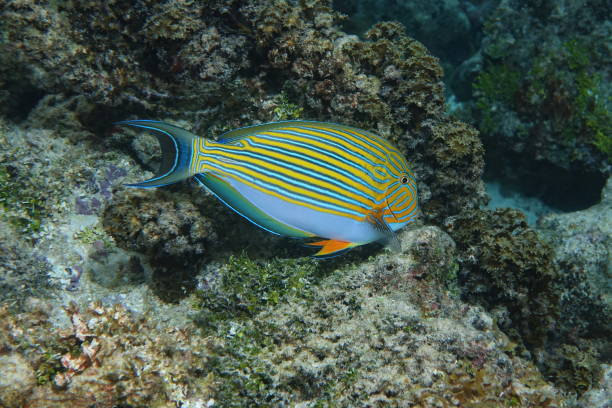Table of Contents
Scientific Classification
| Kingdom | Animalia |
| Phylum | Chordata |
| Class | Actinopterygii |
| Order | Perciformes |
| Family | Acanthuridae |
| Genus | Acanthurus |
| Species | Acanthurus lineatus |
| Scientific Name | Acanthurus lineatus |
Description
The Acanthurus lineatus, commonly known as the blue-lined surgeonfish, is a striking marine fish. A prominent dark band stretches across its eyes, enhancing its fierce and vigilant look.

Distribution
The lined surgeonfish is native to the Indo-Pacific region, inhabiting waters that stretch from the east coast of Africa to the western Pacific Ocean. Its distribution includes:
The Red Sea
The Great Barrier Reef in Australia
The coastlines of Japan, Indonesia, and the Philippines
The islands scattered throughout the Indian Ocean and the Central Pacific
This species thrives in tropical and subtropical waters, especially around coral reefs.
Habitat
Acanthurus lineatus primarily inhabits:
- Coral reefs – Preferring shallow reef flats and outer reef slopes.
- Rocky coastlines – Where algal growth is plentiful.
- Lagoons and reef crests – Where water movement is moderate to strong.
They usually live at depths of 1 to 15 meters (3 to 50 feet). They prefer spots with strong wave action, which help them find algae to eat.
Diet
Lined surgeonfish primarily consume plant material, playing a crucial role in maintaining the health of coral reefs by controlling algae growth. Their diet mainly consists of:
– Filamentous algae
– Macroalgae
– Detritus – They sometimes feed on organic debris that collects on the surfaces of the reef.
These fish possess specialized teeth designed for scraping algae off rocks and corals. They typically feed in groups, which enhances their efficiency and helps deter competitors.
Behavior
Acanthurus lineatus is territorial and aggressive, especially when defending its feeding grounds. Other notable behaviors include:
- Diurnal Activity – Active during the day and resting in reef crevices at night.
- Schooling Behavior – They often form loose groups. But, they can be territorial and aggressive to intruders.
- Territoriality – Males fiercely guard their algae-rich feeding territories against other herbivores.
- Social Hierarchy – It displays dominance over smaller
Lifespan
In the wild, Acanthurus lineatus usually lives for about 10 to 15 years. This lifespan can change depending on environmental conditions and the presence of predators. However, in captivity, they may have a shorter lifespan due to stress and inadequate diet.
Reproduction and Lifecycle
The lined surgeonfish has a reproductive cycle typical of many reef fish.
Spawning Season – This takes place during the warmer months, often aligning with full moons.
External Fertilization: Males and females release their sperm and eggs into the water, where fertilization occurs.
Egg Development – The fertilized eggs hatch into larvae within a few days.
Larval Stage – The larvae drift in plankton-rich waters for several weeks before settling into reefs as juveniles.
Maturity – They reach reproductive maturity in about 1 to 2 years.
Unlike some other reef fish, lined surgeonfish do not engage in parental care. Instead, they rely on ocean currents to help disperse their larvae.

Predators
Adult lined surgeonfish have few natural predators because of their speed and spines. Still, they are vulnerable to:
- Large predatory fish – Such as groupers and trevallies.
- Sharks – Occasionally prey on them in reef ecosystems.
- Human Fishing – Collected for the aquarium trade. In some regions, they’re caught for food.
Juveniles are more vulnerable to predators. They often hide in reef crevices to avoid being eaten.
Adaptations
To thrive in its dynamic reef habitat, Acanthurus lineatus has evolved key adaptations.
- Razor-Sharp Caudal Spines – Used for self-defense against predators and rivals.
- Cryptic Coloration – Bold stripes can confuse predators. They also warn about sharp spines.
- Fast Swimming Ability – Helps evade predators and defend feeding territories.
- Specialized Algal Diet – It controls algal growth on reefs, keeping the balance.
Strong Territorial Instincts – Ensures access to rich feeding grounds, reducing competition for resources.
Conservation Status
- The IUCN categorizes Acanthurus lineatus as Least Concern, indicating that it is not currently at risk of extinction. Nevertheless, there are several factors that could threaten its population:
- Threats:
- Coral Reef Degradation – Resulting from climate change, ocean acidification, and pollution.
- Overfishing – Targeted for the aquarium trade and, in certain regions, for human consumption.
- Habitat Loss – Driven by coastal development and harmful fishing methods.
- Conservation Efforts:
- Marine Protected Areas (MPAs) – Offering safe environments for breeding and feeding.
- Sustainable Fishing Regulations – Established in some areas to curb overfishing.
- Public Awareness Campaigns – Aiming to educate divers and aquarium hobbyists about sustainable practices.
Conclusion
The lined surgeonfish (Acanthurus lineatus) is a vibrant and significant species in marine ecosystems. It plays a crucial role in maintaining the health of coral reefs. With its distinctive appearance, territorial behavior, and specific diet, it captivates the interest of marine enthusiasts. While it is not currently endangered, it is essential to protect this species. Ensuring its survival in the world’s coral reefs is vital for future generations.



